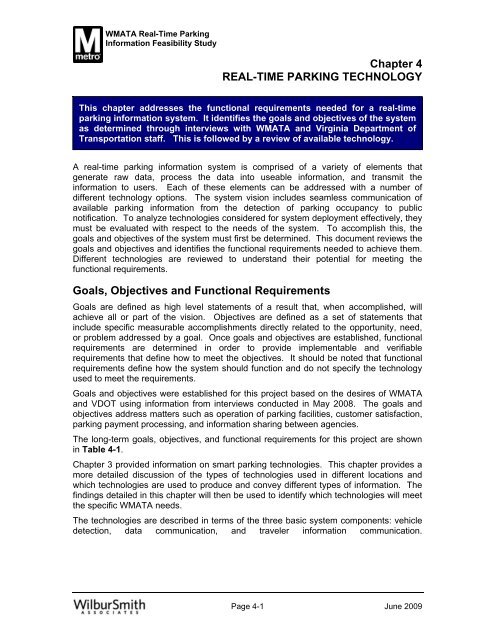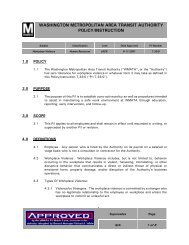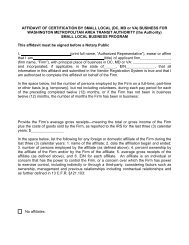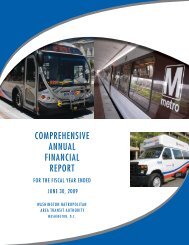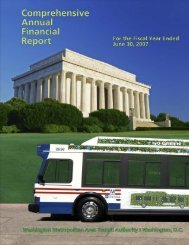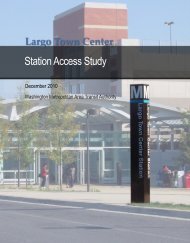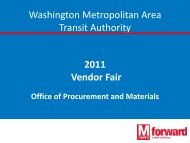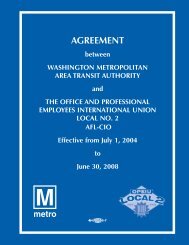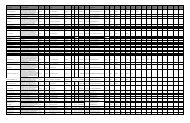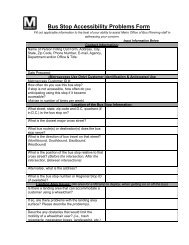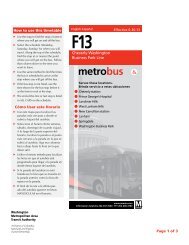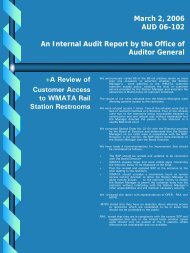feasibility study of real time parking information at ... - WMATA.com
feasibility study of real time parking information at ... - WMATA.com
feasibility study of real time parking information at ... - WMATA.com
You also want an ePaper? Increase the reach of your titles
YUMPU automatically turns print PDFs into web optimized ePapers that Google loves.
<strong>WMATA</strong> Real-Time Parking<br />
Inform<strong>at</strong>ion Feasibility Study<br />
Chapter 4<br />
REAL-TIME PARKING TECHNOLOGY<br />
This chapter addresses the functional requirements needed for a <strong>real</strong>-<strong>time</strong><br />
<strong>parking</strong> <strong>inform<strong>at</strong>ion</strong> system. It identifies the goals and objectives <strong>of</strong> the system<br />
as determined through interviews with <strong>WMATA</strong> and Virginia Department <strong>of</strong><br />
Transport<strong>at</strong>ion staff. This is followed by a review <strong>of</strong> available technology.<br />
A <strong>real</strong>-<strong>time</strong> <strong>parking</strong> <strong>inform<strong>at</strong>ion</strong> system is <strong>com</strong>prised <strong>of</strong> a variety <strong>of</strong> elements th<strong>at</strong><br />
gener<strong>at</strong>e raw d<strong>at</strong>a, process the d<strong>at</strong>a into useable <strong>inform<strong>at</strong>ion</strong>, and transmit the<br />
<strong>inform<strong>at</strong>ion</strong> to users. Each <strong>of</strong> these elements can be addressed with a number <strong>of</strong><br />
different technology options. The system vision includes seamless <strong>com</strong>munic<strong>at</strong>ion <strong>of</strong><br />
available <strong>parking</strong> <strong>inform<strong>at</strong>ion</strong> from the detection <strong>of</strong> <strong>parking</strong> occupancy to public<br />
notific<strong>at</strong>ion. To analyze technologies considered for system deployment effectively, they<br />
must be evalu<strong>at</strong>ed with respect to the needs <strong>of</strong> the system. To ac<strong>com</strong>plish this, the<br />
goals and objectives <strong>of</strong> the system must first be determined. This document reviews the<br />
goals and objectives and identifies the functional requirements needed to achieve them.<br />
Different technologies are reviewed to understand their potential for meeting the<br />
functional requirements.<br />
Goals, Objectives and Functional Requirements<br />
Goals are defined as high level st<strong>at</strong>ements <strong>of</strong> a result th<strong>at</strong>, when ac<strong>com</strong>plished, will<br />
achieve all or part <strong>of</strong> the vision. Objectives are defined as a set <strong>of</strong> st<strong>at</strong>ements th<strong>at</strong><br />
include specific measurable ac<strong>com</strong>plishments directly rel<strong>at</strong>ed to the opportunity, need,<br />
or problem addressed by a goal. Once goals and objectives are established, functional<br />
requirements are determined in order to provide implementable and verifiable<br />
requirements th<strong>at</strong> define how to meet the objectives. It should be noted th<strong>at</strong> functional<br />
requirements define how the system should function and do not specify the technology<br />
used to meet the requirements.<br />
Goals and objectives were established for this project based on the desires <strong>of</strong> <strong>WMATA</strong><br />
and VDOT using <strong>inform<strong>at</strong>ion</strong> from interviews conducted in May 2008. The goals and<br />
objectives address m<strong>at</strong>ters such as oper<strong>at</strong>ion <strong>of</strong> <strong>parking</strong> facilities, customer s<strong>at</strong>isfaction,<br />
<strong>parking</strong> payment processing, and <strong>inform<strong>at</strong>ion</strong> sharing between agencies.<br />
The long-term goals, objectives, and functional requirements for this project are shown<br />
in Table 4-1.<br />
Chapter 3 provided <strong>inform<strong>at</strong>ion</strong> on smart <strong>parking</strong> technologies. This chapter provides a<br />
more detailed discussion <strong>of</strong> the types <strong>of</strong> technologies used in different loc<strong>at</strong>ions and<br />
which technologies are used to produce and convey different types <strong>of</strong> <strong>inform<strong>at</strong>ion</strong>. The<br />
findings detailed in this chapter will then be used to identify which technologies will meet<br />
the specific <strong>WMATA</strong> needs.<br />
The technologies are described in terms <strong>of</strong> the three basic system <strong>com</strong>ponents: vehicle<br />
detection, d<strong>at</strong>a <strong>com</strong>munic<strong>at</strong>ion, and traveler <strong>inform<strong>at</strong>ion</strong> <strong>com</strong>munic<strong>at</strong>ion.<br />
Page 4-1 June 2009


